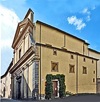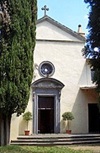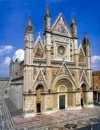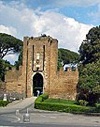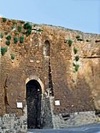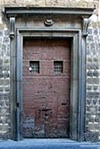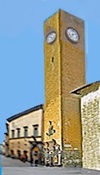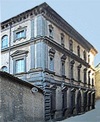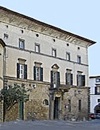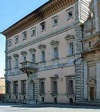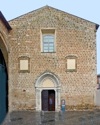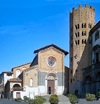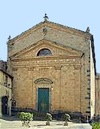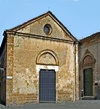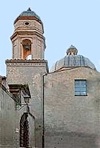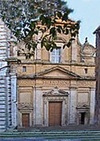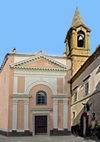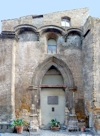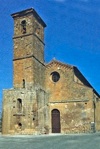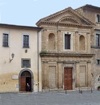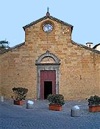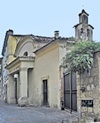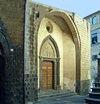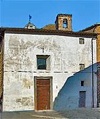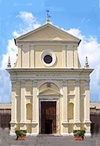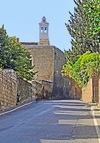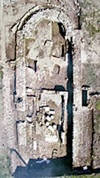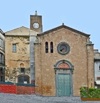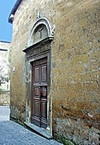Aqueduct (ca. 1276)
This aqueduct fed a number of fountains in the city, including the civic fountain in Piazza Maggiore (now Piazza della Repubblica), which was built at about the same time. It deteriorated over the centuries and fed relatively few fountains in the city by the 17th century.
Chiesa del Buon Gesù (1618-37)
A Franciscan nunnery was established here in 1559-62, and the adjacent church was built in 1618-37. The church of Sant' Onofrio was incorporated into the nunnery in 1633 to serve as the nuns’ private chapel (a function that it still performs). The nuns here had a close association with those at the nearby nunnery of Santa Chiara (below). Both communities were suppressed in the Napoleonic period. The nuns managed to return to the Monastero del Buon Gesù, but Santa Chiara never re-opened.
Convento dei Cappuccini (16th century)
The ex-nunnery of San Bernardo on the hillside overlooking Orvieto passed to a community of Capuchin friars in 1551. They built the present church and convent. St Crispin of Viterbo lived here for forty six years (1702-48). The community was suppressed in 1866, but the Capuchins subsequently returned. The complex later passed into private hands. The Capuchins returned in 1987: the church was then re-consecrated to St Crispin of Viterbo, who had been canonised in 1982.
Duomo
From 1290, when Pope Nicholas IV laid its foundation stone, the Duomo has received the attention of some of the leading Italian artists. Its facade is one of the few in Italy that was actually completed, albeit that this took some 300 years. The frescoes (1499-1504) in the Cappella Nuova by Luca Signorelli are outstanding.
Fortresses of Orvieto
The earliest known fortress here was documented in 1342, but the most famous one was the Rocca dell’ Albornoz (1364-70). It was continually adapted until 1435, when peace returned to Orvieto for the first time in a century and the citizens took the opportunity to demolish what was left of it.
Gates of Orvieto (originally 12th or 13th century)
It seems that there was only one entrance to the ancient city, a road cut through the tufa that became Via della Cava. There was probably a gate half way along it, at least by Roman times. The medieval city had five gates:
-
•Porta Maggiore, at the end of Via della Cava (illustrated here);
-
•Porta Santa Maria;
-
•Porta Soliana;
-
•Porta Vivaria; and
-
•Porta Pertusa.
Porta Romana (1822) replaced the last of these when Via Cassia Nuova was constructed to improve road access to the city.
Oratorio della Misericordia (16th century)
The Società di San Girolamo acquired the church and adjacent nunnery of Sant’ Agnese here in 1495. This church was already used by the Compagnia della Misericordia. The two were merged to form the Confraternita di San Giovanni Decollato in 1556. The confraternity subsequently built the oratory next to Sant’ Agnese.
Palazzo Comunale (1574-81)
What was probably the first civic palace of Orvieto was built next to Sant’ Andrea (below) in 1216-9. This palace was destroyed in a fire and rebuilt in 1255-76. By 1485, this palace was in such a poor state or repair that the Council held its meetings in the Palazzo Vescovile (below). Ippolito Scalza was finally commissioned to rebuild the palace in 1573, according to the design by Antonio da Sangallo the Younger, and it returned to use in 1580.
Palazzo dell' Opera del Duomo (remodelled in 1857-99)
The Opera del Duomo, which owned most of this site from at least 1356, built a palace here in 1623-9. It acquired adjacent properties in the 19th century and Virginio Vespignani designed the extension of the palace to the right in 1857. Its facade took on its present symmetrical appearance during a further remodelling by Paolo Zampi in 1898-9.
Palazzi Papali (ca. 1262-92)
An analysis of the architecture of this papal complex suggests that it was built in three distinct phases, probably by:
-
•Pope Urban IV resided in Orvieto from October 1262 until September 1264;
-
•Pope Martin IV was crowned in Orvieto in March 1281 and who remained here until June 1284; and
-
•Pope Nicholas IV resided in Orvieto from June 1290 until October 1292.
It now houses the Museo Archeologico Nazionale and the Museo dell’ Opera del Duomo.
Palazzo del Popolo (1280-1316)
This palace was built by Ranieri della Greca, who instituted the government of the Popolo in Orvietoand served as Capitano del Popolo on two occasions in 1280-4. The magistracy of the Signori Sette (below) met here from their foundation in 1292 until 1319, when they acquired their own premises. The papal vicars occupied the palace in 1398-1408 and a series of "foreign" Podestà resided here thereafter. The complex was restored and adapted to form a space for exhibitions and seminars in 1984-9. The excavations of the site made at that time revealed the remains of an Etruscan temple (5th century BC).
Torre del Moro (13th century) and Palazzo dei Signori Sette (1319)
The imposing tower here, which originally formed part of a tower house that belonged to the Della Terza family, subsequently passed into papal ownership, and was then known as the Torre del Papa. Its present name probably derives from that of Raffaele di Sante Gualterio, known as “il Moro”, who is said to have resided in the tower in the 16th century.
The magistracy of the Signori Sette (the leaders of the seven most important guilds) built an adjoining L-shaped palace here in 1319. Work to adapt the complex as the Palazzo del Governatore began in 1553. Raffaello da Montelupo seems to have supervised the project in 1553-64. Work began again in 1571, almost certainly under the direction of Ippolito Scalza.
Palazzo Soliano (1297-1359)
The Commune began the construction of this palace in 1297 at the behest of Pope Boniface VIII, but it was still in construction when he died in 1303. The unfinished building was then abandoned until 1321, when the Opera del Duomo acquired it to house the workmen who were engaged in building the Duomo. It subsequently had a chequered history. It owes its current appearance to a major restoration carried out in 1887-98 by Paolo Zampi in what he believed to be its original form. It now houses the Museo Emileo Greco on the ground floor, and a number of mostly Roman objects are arranged somewhat haphazardly under its loggia.
Palazzo Vescovile (1956)
This has long been the centre of episcopal authority in Orvieto. The first palace here, which was probably built in the 11th century, was rebuilt in 1178. A series of popes seem to have stayed here when they visited the city, and the complex was extended by the construction of a series of new papal palaces (above) in the 13th century). The bishops of Orvieto probably used the whole complex from the 14th century, when Orvieto ceased to be used as a papal residence. When Palazzo Comunale (above) became unfit for use in ca. 1485, the Commune held its meetings here, a practice that continued until 1580.
Palazzo Buzi (1581)
Vicenzo Buzi bought the vineyard and orchards here from the nuns of San Bernardino (below) in 1581, and commissioned Ippolito Scalza to build this palace on the site. The Gualterio family acquired it in the 18th century. It passed to the Padri Mercedari, its current owners, in 1899.
Palazzo Carvajal (16th century)
Cardinal Girolamo Simoncelli built the original palace here in 1548. It probably took on its present form after it passed to Caravajal dei Caravajal-Simoncelli, Bishop of Sovana (1535-96). The palace is often attributed to Ippolito Scalza, although his hand can only be easily recognised in the main portal. Caravajal dei Caravajal-Simoncelli built and endowed the Oratorio di San Sabino inside the palace in 1571.
Palazzo Sforza Monaldeschi della Cervara (1570-4)
Simone Mosca probably designed this palace, which was built by Sforza Monaldeschi della Cervara. Ippolito Scalza probably completed its construction in 1572-4. It passed to the Counts of Marsciano in the early 17th century. Pope Leo XIII approved its adaptation by Paolo Zampi to form the Collegio Leonino in 1893. It now houses the Istituto Statale d'Arte.
Other Patrician Palaces
This page describes the following palaces:
-
•Palazzo Alberi;
-
•Palazzo Aureli-Missini;
-
•Palazzo Aviamonzi Alberici;
-
•Palazzo Bracci;
-
•Palazzo Clementi;
-
•Palazzo Crispo Marsciano (illustrated here);
-
•Palazzo Faina;
-
•Palazzo Febei (in Corso Cavour);
-
•Palazzo Febei (in Piazza Febei);
-
•Palazzo Filippeschi Simoncelli
-
•Palazzo Gualterio;
-
•Palazzo Mancini;
-
•Palazzo de’ Medici;
-
•Palazzo Ottaviani;
-
•Palazzo Petrucci;
-
•Palazzo Ravizza;
-
•Palazzo Saracinelli;
-
•Palazzo Simoncelli.
Pozzo di San Patrizio (1527-37)
Antonio di Sangallo il Giovane, who discovered the water source known as the Sorgente di Santo Serio here, began work on the well when Pope Clement VII fled to Orvieto in December 1527, after the sack of Rome. Itl is over 50 meters deep, and two concentric spiral staircases of 250 steps allowed the donkeys plodding up and down to bring water to the surface without turning. Construction remained incomplete when Pope Paul III visited the city in 1536, after which Simone Mosca brought the project to completion.
Sant' Agostino (13th century)
A group of hermits that bought the church of Santa Lucia here in ca. 1255 was formalised within the Augustinian Order in 1263. The friars intended to build a new church and then to demolish Santa Lucia. The project began in 1264, but it proved to be too ambitious: it was abandoned in the middle of the 14th century. The friars then adapted the old church to meet their needs. The community was suppressed in 1810. The deconsecrated church was restored in the 1980s and the church has recently been adapted to house the collection of Baroque sculpture of the Museo dell' Opera del Duomo.
Sant' Andrea (1013 ?)
Excavations under the present church have shown that it stands on an Etruscan site, and that churches existed here form the 6th century. This church was replaced by another that seems to have been consecrated in 1013. It was the most important in Orvieto until late in the 13th century, and was used on important civic as well as religious occasions. It suffered some form of catastrophic collapse in 1512 and had to be largely rebuilt. The adjacent campanile partially collapsed in 1514. The church and campanile were restored in 1928 and again in 1992.
Sant’ Angelo (1828)
This was the site of one of the oldest churches in Orvieto. A small room built in tufa that was discovered near the apse in 1933 has been dated to the 5th or 6th century. A church that was built here in the 11th century was recorded as a possession of the Abbazia di SS Severo e Martirio (below) in 1297 and was restored and enlarged in 1333. The supposed relics of SS Severus and Martirius were moved here from the Abbazia di SS Severo e Martirio in 1613. The church was rebuilt in 1828 and consecrated in 1838.
Sant’ Antonio Abate (15th century)
This church and monastery, together with an adjacent hospice, belonged to the Canons Regular of St Antony of Vienne. The church was first documented in 1350, and the Conservatori della Pace gave permission for its rebuilding in 1492. The complex was suppressed in 1860and was subsequently ruined. The church has since been converted for use as a gymnasium. An altarpiece (ca. 1493) of St Antony Abbot enthroned, which is attributed to Antonio da Viterbo, il Pastura, still survives in its lovely Renaissance frame on the back wall.
SS Apostoli Filippo e Giacomo (1819)
The original church here was built in 1007. The Jesuits, who arrived in Orvieto in 1621, moved here in 1625. They bought adjacent properties to provide a site for a college, and the Seminario Vescovile was moved here and placed under the Jesuit’s control. They were expelled following the suppression of their order in 1773. The Seminario Vescovile passed into direct episcopal control in 1778, but the church was abandoned. The church was rebuilt when the Jesuits were recalled in 1819. The campanile was built in 1834, but the facade of the church remains incomplete. The Jesuits were finally expelled in 1860. The church became unstable and was closed in 1965. It was finally restored in 1991-5, and its Baroque altars were restored in 1995-6. Unfortunately, it is usually closed.
San Bernardino (1657-66)
A nunnery for female Franciscan tertiaries was built here in 1453. This community was suppressed in 1544 and the complex passed to a community Poor Clares. The new church that they built in 1657-66 was finally consecrated in 1739.
Santa Chiara (1493)
This church, which was first documented in 1350, seems to have belonged to the Poor Clares of San Lorenzo delle Vigne, as did the church of San Lodovico (see below for both). They took refuge here during the wars of the late 14th century. In 1436, they moved permanently to San Lodovico and Santa Chiara. The church was rebuilt in 1493 and the convent in 1520. The nuns here had a close association with those at the Chiesa del Buon Gesù (above) from the early 17th century. Both communities were suppressed in the Napoleonic period, and Santa Chiara never re-opened.
San Domenico (1235-64)
The Dominicans took over an existing church here in 1232 and soon began to rebuild it. St Thomas Aquinas taught theology at the convent in 1261-5. PopeUrban IV consecrated San Domenico in 1264, although it is possible that its nave was not completed until ca. 1285. Four cardinals who died at the papal court in Orvieto in the 13th century were buried in the church: the monument (ca. 1282) of Cardinal Guillaume de Bray is the only one of them that survives. The church was remodelled in 1680, when half of the nave was demolished. The Fascist government destroyed the nave of the church and adjoining convent in 1934. (The present facade was originally the back wall of the right transept).
San Francesco (1240-66)
A Franciscan hermitage was established outsideOrvieto before 1217. The friars began the construction of the present church and adjacent convent in 1234 and moved here in 1243. Pope Clement IV consecrated the new church in 1266. When the Franciscans left the convent in 1815, it passed to the Jesuits, who lived here until they were expelled in 1860. It was used as a military complex in the period 1878-1955. The deconsecrated church was reopened to the public in 1999, after a long period of closure. Part of the convent is to be adapted to house the Biblioteca Comunale.
San Giacomo Maggiore (1835)
A hospice for poor people and pilgrims was established here in 1187. Pope Clement IV gave permission for the erection of a chapel and cemetery here in 1266. In 1288, Pope Nicholas IV associated the brothers who administered the complex with the Cavalieri di San Giacomo di Altopascio and charged them with the care for pilgrims taking Via Francigena to Rome. The chapel seems to have become dilapidated by 1790 and was rebuilt in its present form in 1830-5. The hospital was rebuilt to a plan by Paolo Zampi in 1892-1910. It closed in 2000, when the new Ospedale di Santa Maria della Stella opened at nearby Ciconia. The complex now belongs to the Centro Studi Città di Orvieto.
San Giovanni Evangelista (1697-1704)
A church here, which was built on the site of an Etruscan temple dedicated to Tinia (Zeus, Jove), was documented after its restoration in 1003. A community of canons was established here soon after. Pope Innocent III consecrated it in 1216, presumably after another restoration. In 1498, Pope Alexander VI transferred the complex to a congregation of Lateran Canons based at San Salvatore, Bologna. A bequest from Bishop Giorgio della Rovere financed the restoration of the complex in ca. 1505. An earthquake destroyed the church in 1687 and it was demolished a decade later. It was rebuilt with the opposite orientation and on an octagonal plan, to a design by Giovanni Battista Arrigoni. The facade was completed in 1857 and the campanile was built in 1928.
San Giovannino dei Cavalieri di Malta (12th century)
This complex originally belonged to the Knights Templar, who had established their local headquarters outside Orvieto in 1135. The knights probably fled from the region in 1312, when their order was suppressed. The complex subsequently passed to the Knights of St John of Jerusalem, who re-dedicated the church to their patron, St John the Baptist. The community was suppressed in 1810 and again, this time definitively, in 1860.
San Giovenale (1003)
The first church was probably built here soon after the re-population of Orvieto in the 6th century. It probably received its current dedication in 880, when the stolen relics of St Juvenal of Narni were translated along Via Cassia from Lucca, back to their native city. A group of noble families apparently financed its rebuilding in 1004. It was documented as a parish church in 1028, and it had a college of canons by 1154. By 1170, it belonged to the Hermits of St William. It became a parish church again in ca. 1248, and was administered by a small community of canons. The old apse was demolished in the late 13th century, to allow the church to be extended towards the liturgical east.
San Lodovico (1746)
The original church here, which was documented in 1350, seems to have belonged to the Poor Clares of San Lorenzo delle Vigne (below), as did the church of Santa Chiara (above). They took refuge here during the wars of the late 14th century. The nuns moved permanently to San Lodovico and Santa Chiara in 1436. The church was rebuilt in 1746, at which point its orientation was changed so that its façade, which originally faced the cliff, now faced Piazza Ranieri. In 1834, the nunnery passed to the nuns of the Order of the Company of Mary Our Lady. The church closed for restoration in 2000 and re-opened in 2005.
San Lorenzo de' Arari (before 1291)
The church is named for the Etruscan altar (arari) that supports the mensa of the main altar. The earliest reference to a church with this dedication dates to 1028, when Bishop Sigifredo conceded it to the canons of San Costanzo. However, in 1291, the Franciscans from the neighbouring San Francesco objected to the disturbance from its bells and insisted on its demolition. The altar was moved to the present church, which was slightly further away.
San Lorenzo delle Vigne (1557-61)
Pope Gregory IX established a nunnery of Poor Clares here in 1225-32, among the vineyards outside Orvieto. The complex was badly damaged in the fighting between papal forces and the rebellious Giovanni di Vico in 1354, when the nuns took refuge in Orvieto, probably at San Lodovico and Santa Chiara (above). They moved permanently to these more secure nunneries in 1436. The Commune commissioned Raffaello da Montelupo to build the present church and adjacent convent, which became the home of a male Franciscan community. Ippolito Scalza worked continually on the structure in the following years, addressing its chronic instability. The church was once more in ruins in 1667, when Monaldo Monaldeschi della Cervara paid for its restoration for a reformed male Franciscan community. Virginio Vespignani designed the new cemetery that was established here after the unification of Italy in 1860. Unfortunately, the church is now closed and in a bad state of repair.
Santa Maria del Campione (1797)
The people of Orvieto built this shrine in 1797 to house an ancient image of the Virgin that was seen to move its eyes. (Miracles of this sort were reported in many places in Italy as Napoleon's army invaded). The image was known as the Madonna del Campione, presumably because it was originally placed above the “campione di misura”, which were used for the periodic checking weights and measures, in order to stimulate the honesty of the traders who used them. The image in question is presumably that above the altar.
Santa Maria del Carmine (1328)
The Carmelites, who were the last of the mendicant orders to arrive in Orvieto, built their church and adjacent convent in the open loggia known as the Loggia dei Mercanti. Work on the church was completed in 1328 and the convent was finished in 1360. The Confraternita del Carmine, which was established in 1559 in an adjacent oratory, undertook the Baroque remodelling of the church. The convent was suppressed in 1810. Part of the convent was then demolished and the rest was adapted for residential use. However, the confraternity continued in operation into the 20th century. The church was then abandoned, and its roof collapsed. It has since been adapted for secular use after its restoration in the 1990s. The complex now houses the Collettivo Teatro Animazione.
Santa Maria della Cava (1640)
The Confraternita dei Fabbri (guild of blacksmiths) built this Baroque church on the site of the earlier church (12th century) of Sant’ Eligio. It was closed in the 1980s but has now been restored and was reopened in 2003. The restored church was dedicated to the Virgin in honour of a miraculous fresco of the Madonna and Child, a fragment of which survives above the altar. This is probably from the fresco that was originally in Santa Maria della Fonte (below).
Santa Maria della Fonte (1490-9)
This church was built next to a fountain to house a venerated fresco (14th century) of the Madonna and Child. Pope Urban VIII ordered its destruction, in order to make way for defensive structures to protect Porta Maggiore during the War of Castro. The fragment of fresco in Santa Maria della Cava (above) probably came from the venerated image here.
The bastion that replaced the church survives, together with vestiges of the fountain. The fragmentary inscription above it records that Aloysius Danielli restored it in 1764.
Santa Maria dei Servi (1857-75)
A community of Servites settled outside Orvieto in 1259 and moved to San Pietro in Vetere (below) in 1260. The friars bought land on the present site in 1268 for a new church and convent. The church was completed by ca. 1290. It was in ruins by 1857, when Virginio Vespignani was commissioned to design its replacement. Work was halted by the civil unrest of 1860. The complex was used as a barracks until 1870 and undermined by an earthquake in 1873. It was restored and consecrated in 1875.
San Paolo (1221)
This Benedictine nunnery was established in 1221. The nuns transferred to the Dominican Order in 1303. They subsequently absorbed the nuns of four earlier communities: Santa Cecilia; Sant’ Agnese; Santa Caterina; and San Pancrazio. They were also involved on occasion in the reform of other nunneries. The community was suppressed in 1810 and the complex was transferred to a community of nuns dedicated to the Sacred Heart in 1842. Some of the nuns moved to San Salvatore (in “Other Churches below) in 1922.
San Pietro in Vetere (12th century ?)
Excavations here (Campo della Fiera) in 2001 revealed that this had been a cult site from Etruscan times until the Middle Ages. The remains of a church in the upper layers of the excavations probably belonged to San Pietro in Vetere, which was documented from 1211. It was ceded in turn to two newly-arrived mendicant orders:
-
•to the Franciscans in ca. 1217-43, before they moved to San Francesco (after the death of St Ambrose of Massa in 1240); and
-
•to the Servites in 1260-5, before they moved to Santa Maria dei Servi.
Once the mendicants had moved to their respective urban churches (above), San Pietro in Vetere served the suburb that flourished here until the Black Death (1348) wiped it out.
San Rocco (1526)
The Compagnia di San Rocco acquired a derelict church here after an outbreak of plague in 1522-4. The site was part of the complex of the Palazzo delle Sette (above). Michele Sanmicheli, who was a prominent member of the confraternity, probably designed the new church. Although the portal is original, the rest of the façade was rebuilt in 1930. The church, which is now deconsecrated, was restored in 2007 and is sometimes open for exhibitions.
SS Severo e Martirio (11th century)
This abbey, which is dedicated to SS Severus and Martirius, stands on the site on which St Severus was apparently buried. The site belonged to the Benedictines, who built a church and monastery here, probably in ca. 600. An inscription records that the church was re-consecrated (presumably after rebuilding) in 1054. The complex passed to a community of Premonstratensian canons in 1220 and then to the Olivetans in 1423. It passed in commendum to the future Pope Paul II in 1442 and was in ruins by 1449. The supposed relics of SS Severus and Martirius were moved to Sant' Angelo (above). The abbey is now a hotel.
Santo Stefano (13th century)
This Romanesque church has a lovely campanile and a tiny pensile apse that overhangs Via Santo Stefano.
SS Trinità (15th century)
A Benedictine monastery and hospice, which was established on this site outside Orvieto in 1038, passed to a Cistercian community in 1265. The complex passed to the Observant Franciscans in 1429 and they rebuilt the church and convent. This community was suppressed in 1860, after which the complex housed an agricultural business. It is currently (May 2008) undergoing a major restoration that will convert it into a hotel and conference centre.
Other Churches in Orvieto
-
•Sant’ Anna dei Padri Riformati;
-
•Chiesa dell’ Annunziata (illustrated here);
-
•San Bernardo and San Carlo Borromeo;
-
•Cappella del Crocifisso del Tufo;
-
•Oratorio di San Giovanni Battista dei Disciplinati;
-
•San Giuseppe;
-
•Santa Lucia;
-
•Santa Maria del Pianto;
-
•Santa Maria del Velo;
-
•San Salvatore
-
•Chiesa degli Scalzi;
-
•Santo Spirito degli Armeni.
Teatro Comunale (1841-66)
The first theatre here was built in 1841. In 1853, the Commune took over the project and commissioned Virginio Vespignani to redesign and rebuild it, and it opened in 1866. It is now known as Teatro Mancinelli in honour of the composer Luigi Mancinelli (died 1921), who was born in Orvieto.



